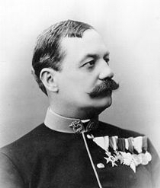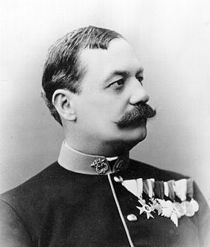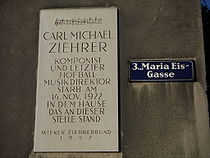
Karl Michael Ziehrer
Encyclopedia

Austria
Austria , officially the Republic of Austria , is a landlocked country of roughly 8.4 million people in Central Europe. It is bordered by the Czech Republic and Germany to the north, Slovakia and Hungary to the east, Slovenia and Italy to the south, and Switzerland and Liechtenstein to the...
n composer
Composer
A composer is a person who creates music, either by musical notation or oral tradition, for interpretation and performance, or through direct manipulation of sonic material through electronic media...
. In his lifetime, he was one of the fiercest rivals of the Strauss family; most notably Johann Strauss II
Johann Strauss II
Johann Strauss II , also known as Johann Baptist Strauss or Johann Strauss, Jr., the Younger, or the Son , was an Austrian composer of light music, particularly dance music and operettas. He composed over 500 waltzes, polkas, quadrilles, and other types of dance music, as well as several operettas...
and Eduard Strauss
Eduard Strauss
Eduard Strauss was an Austrian composer who, together with brothers Johann Strauss II and Josef Strauss made up the Strauss musical dynasty. The family dominated the Viennese light music world for decades, creating many waltzes and polkas for many Austrian nobility as well as dance-music...
.
Biography
Born in ViennaVienna
Vienna is the capital and largest city of the Republic of Austria and one of the nine states of Austria. Vienna is Austria's primary city, with a population of about 1.723 million , and is by far the largest city in Austria, as well as its cultural, economic, and political centre...
, Ziehrer was taught music by Simon Sechter
Simon Sechter
Simon Sechter was an Austrian music theorist, teacher, organist, conductor and composer.Sechter was born in Friedberg , Bohemia, then part of the Austrian Empire, and moved to Vienna in 1804, succeeding Jan Václav Voříšek as court organist there in 1824. In 1810 he began teaching piano and voice...
, a famous Viennese music theorist and pedagogue. He was soon discovered by music publisher Carl Haslinger, one of Johann Strauss II's publishers, who had fallen out with Strauss regarding the receipts from the latter's lucrative Russian venture.
Ziehrer was, in the words of Strauss' first wife, Henrietta Treffz
Henrietta Treffz
Henrietta "Jetty" Treffz was best known as the first wife of Johann Strauss II and a well-known mezzo-soprano appearing in England in 1849 to great acclaim.-Biography:...
, "one of Haslinger's machinations," and "what Haslinger writes as his own would be passed on the ward to be published as his own." Her prophecy was, however, only ever partially fulfilled; though Ziehrer's pulsating and lively waltz
Waltz
The waltz is a ballroom and folk dance in time, performed primarily in closed position.- History :There are several references to a sliding or gliding dance,- a waltz, from the 16th century including the representations of the printer H.S. Beheim...
es lit up Vienna
Vienna
Vienna is the capital and largest city of the Republic of Austria and one of the nine states of Austria. Vienna is Austria's primary city, with a population of about 1.723 million , and is by far the largest city in Austria, as well as its cultural, economic, and political centre...
, and though he challenged the famed Strauss family for the Viennese public's affections, his many works have not survived long in today's classical repertoire.
Haslinger sought to promote his promising young ward, and in 1863, the young conductor appeared as the head of a newly-formed orchestra aimed at toppling the Strauss dynasty at the Dianabad-saal in Vienna
Vienna
Vienna is the capital and largest city of the Republic of Austria and one of the nine states of Austria. Vienna is Austria's primary city, with a population of about 1.723 million , and is by far the largest city in Austria, as well as its cultural, economic, and political centre...
. Not long after that, he secured a place at one of Viennese military bands. As was the current trend, he took over as Kapellmeister
Kapellmeister
Kapellmeister is a German word designating a person in charge of music-making. The word is a compound, consisting of the roots Kapelle and Meister . The words Kapelle and Meister derive from the Latin: capella and magister...
of a large civilian orchestra in 1873. He also published the journal "Deutsche Musikzeitung" around the same time, and was credited as being one of the important sources of music study in the late 1870s.
Not long after founding the music journal, he changed his publisher to Döblinger, and toured Eastern Europe
Eastern Europe
Eastern Europe is the eastern part of Europe. The term has widely disparate geopolitical, geographical, cultural and socioeconomic readings, which makes it highly context-dependent and even volatile, and there are "almost as many definitions of Eastern Europe as there are scholars of the region"...
and Germany
Germany
Germany , officially the Federal Republic of Germany , is a federal parliamentary republic in Europe. The country consists of 16 states while the capital and largest city is Berlin. Germany covers an area of 357,021 km2 and has a largely temperate seasonal climate...
for many years, earning a good reputation as a strict yet efficient conductor
Conducting
Conducting is the art of directing a musical performance by way of visible gestures. The primary duties of the conductor are to unify performers, set the tempo, execute clear preparations and beats, and to listen critically and shape the sound of the ensemble...
. It was in 1881 that he met his future wife, Marianne Edelmann, a famous operetta
Operetta
Operetta is a genre of light opera, light in terms both of music and subject matter. It is also closely related, in English-language works, to forms of musical theatre.-Origins:...
singer, in Berlin
Berlin
Berlin is the capital city of Germany and is one of the 16 states of Germany. With a population of 3.45 million people, Berlin is Germany's largest city. It is the second most populous city proper and the seventh most populous urban area in the European Union...
.
Throughout the period between 1885 and 1893, Ziehrer toured extensively and was a military bandmaster, having achieved the distinction of "Übernahme der Militärmusik der Hoch", as well as the "Deutschmeister" decoration. His fame was such that he was invited to perform at the World Exhibition in Chicago
Chicago
Chicago is the largest city in the US state of Illinois. With nearly 2.7 million residents, it is the most populous city in the Midwestern United States and the third most populous in the US, after New York City and Los Angeles...
in 1893. After that, in a flurry of events, he toured 41 German
Germany
Germany , officially the Federal Republic of Germany , is a federal parliamentary republic in Europe. The country consists of 16 states while the capital and largest city is Berlin. Germany covers an area of 357,021 km2 and has a largely temperate seasonal climate...
cities and finally returned to Vienna
Vienna
Vienna is the capital and largest city of the Republic of Austria and one of the nine states of Austria. Vienna is Austria's primary city, with a population of about 1.723 million , and is by far the largest city in Austria, as well as its cultural, economic, and political centre...
, where he formed an even larger and successful orchestra that specialized in playing dance music. At this point, his works began to gain a wider circulation among the music-loving Viennese, and works such as Weaner Mad'ln op. 388, as well as the more famous Wiener Bürger op. 419, were received with greater appreciation, the latter even temporarily triumphing over Strauss compositions when first published in 1890.
Despite being a strong challenger of the Strauss music dynasty, he was unable to triumph over them and remained under their influence, which numbered among them his personal appearance; he maintained a 'Schnurrbart' moustache as well as a similar hair-style. By the turn of the century, Ziehrer felt that he needed to devote his time and attention towards composing, and his military band participation waned until he relinquished his last position in 1899, the year Johann Strauss II
Johann Strauss II
Johann Strauss II , also known as Johann Baptist Strauss or Johann Strauss, Jr., the Younger, or the Son , was an Austrian composer of light music, particularly dance music and operettas. He composed over 500 waltzes, polkas, quadrilles, and other types of dance music, as well as several operettas...
died.
Ziehrer enjoyed success in the operetta
Operetta
Operetta is a genre of light opera, light in terms both of music and subject matter. It is also closely related, in English-language works, to forms of musical theatre.-Origins:...
writing business, with stage works such as Die Landstreicher
Die Landstreicher
Die Landstreicher is an operetta in one prologue and two acts by Karl Michael Ziehrer...
in 1899, but it was with the operetta Fremdenführer (Tourist Guide) that he achieved stage success. He was one of the composers who bridged the 'Golden Age' of operetta with the new influence of the emerging 'Silver Age', with composers such as Franz Lehár
Franz Lehár
Franz Lehár was an Austrian-Hungarian composer. He is mainly known for his operettas of which the most successful and best known is The Merry Widow .-Biography:...
, who would dominate the operetta scene for many years later on.

Johann Strauss I
Johann Strauss I , born in Vienna, was an Austrian Romantic composer famous for his waltzes, and for popularizing them alongside Joseph Lanner, thereby setting the foundations for his sons to carry on his musical dynasty...
more than half a century earlier, and subsequently dominated within the Strausses with Johann Strauss II
Johann Strauss II
Johann Strauss II , also known as Johann Baptist Strauss or Johann Strauss, Jr., the Younger, or the Son , was an Austrian composer of light music, particularly dance music and operettas. He composed over 500 waltzes, polkas, quadrilles, and other types of dance music, as well as several operettas...
and Eduard Strauss
Eduard Strauss
Eduard Strauss was an Austrian composer who, together with brothers Johann Strauss II and Josef Strauss made up the Strauss musical dynasty. The family dominated the Viennese light music world for decades, creating many waltzes and polkas for many Austrian nobility as well as dance-music...
also holding the office for many years. He was also the last person to hold this post, with the destruction of the Habsburg
Habsburg
The House of Habsburg , also found as Hapsburg, and also known as House of Austria is one of the most important royal houses of Europe and is best known for being an origin of all of the formally elected Holy Roman Emperors between 1438 and 1740, as well as rulers of the Austrian Empire and...
dynasty in World War I
World War I
World War I , which was predominantly called the World War or the Great War from its occurrence until 1939, and the First World War or World War I thereafter, was a major war centred in Europe that began on 28 July 1914 and lasted until 11 November 1918...
resulting in its dissolution. During the time before the war, he worked well with composers Franz Lehár
Franz Lehár
Franz Lehár was an Austrian-Hungarian composer. He is mainly known for his operettas of which the most successful and best known is The Merry Widow .-Biography:...
, Oscar Straus
Oscar Straus (composer)
Oscar Nathan Straus was a Viennese composer of operettas and film scores and songs. He also wrote about 500 cabaret songs, chamber music, and orchestral and choral works...
, and Leo Fall
Leo Fall
Leo Fall was an Austrian composer of operettas.-Life:Born in Olmütz , Leo Fall was taught by his father Moritz Fall , a bandmaster and composer, who settled in Berlin. The younger Fall studied at the Vienna Conservatory before rejoining his father in Berlin...
, and was guest conductor at their concerts on many occasions.
The outbreak of the war sealed his career as a composer
Composer
A composer is a person who creates music, either by musical notation or oral tradition, for interpretation and performance, or through direct manipulation of sonic material through electronic media...
, and most of his property was destroyed. He died a poor and forgotten man on 14 November 1922 in Vienna
Vienna
Vienna is the capital and largest city of the Republic of Austria and one of the nine states of Austria. Vienna is Austria's primary city, with a population of about 1.723 million , and is by far the largest city in Austria, as well as its cultural, economic, and political centre...
. He was buried in the Zentralfriedhof
Zentralfriedhof
The Zentralfriedhof is one of the largest cemeteries in the world, largest by number of interred in Europe and most famous cemetery among Vienna's nearly 50 cemeteries.-Name and location:...
in the graves of honour. His wife was buried beside him.
His rich musical heritage may not be comparable to the Strausses, who dominated for well over a century, but he was more prolific, having composed over 600 waltz
Waltz
The waltz is a ballroom and folk dance in time, performed primarily in closed position.- History :There are several references to a sliding or gliding dance,- a waltz, from the 16th century including the representations of the printer H.S. Beheim...
es, polka
Polka
The polka is a Central European dance and also a genre of dance music familiar throughout Europe and the Americas. It originated in the middle of the 19th century in Bohemia...
s and march
March (music)
A march, as a musical genre, is a piece of music with a strong regular rhythm which in origin was expressly written for marching to and most frequently performed by a military band. In mood, marches range from the moving death march in Wagner's Götterdämmerung to the brisk military marches of John...
es, which are still performed today. Some of his works are even more Viennese in nature than that of the Strausses. His works are vigorous and forceful, with cheerful melodies written even near the end of the Habsburg
Habsburg
The House of Habsburg , also found as Hapsburg, and also known as House of Austria is one of the most important royal houses of Europe and is best known for being an origin of all of the formally elected Holy Roman Emperors between 1438 and 1740, as well as rulers of the Austrian Empire and...
dynasty.

